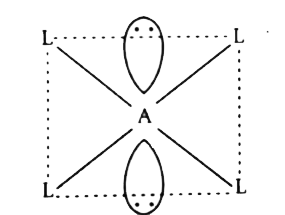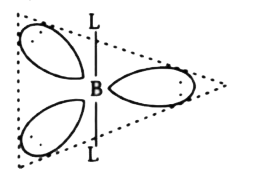Consider two covalent compounds ALn1andBLn2, if central atom (A) of first compounds has total six electron pairs and central atom (B) of second compound contains total five electron pairs in its valence shell and both compounds are planar and non-polar then calculate value of experssion (n1−n2)2.
[Where n1andn2 are number of monovalent surrounding atom (L)]
The correct Answer is:4
⇒ALn1:  impliesNumberofe≤ctronpaironA=6<br>impliesNon−polar<br>impliesplanar<br>Hencen_(1)=4<br>implies BL_(2):
impliesNumberofe≤ctronpaironA=6<br>impliesNon−polar<br>impliesplanar<br>Hencen_(1)=4<br>implies BL_(2): 
⇒ Number of electron pair on B=5
⇒ Non-polar
⇒ planar
Hence n2=2
(n1−n2)2=(4−2)2=4
Topper's Solved these Questions
Similar Questions
Consider the following table

Than calculate value of experssion ∣∣∣n1+n2+n3+n4m1+m2+m3+m4∣∣∣2.View SolutionIf hydrolysis of interhalogen compound can be represented by following general reaction:
XYn1water−−→n1HY+HXOn2
If given interhalogen compound is polarr and non-planar, then calculate value of n1+n2.View Solution
Knowledge Check
- Question 1 - Select One
A natural atom of an element has 2K,8L,9M and 2N electrons .The atomic number of element is :
The total number of unpaired electons areA1B2C3D4 - Question 2 - Select One
A natural atom of an element has 2K,8L,9M and 2N electrons .The atomic number of element is :
The total number of s electons areA8B6C4D10 - Question 3 - Select One
A natural atom of an element has 2K,8L,9M and 2N electrons .The atomic number of element is :
The total number of d electons areA1B2C3D4
If hydrolysis of interhalogen compound can be represented by following general reaction:
XYn1water−−→n1HY+HXOn2
If given interhalogen compound is polarr and non-planar, then calculate value of n1+n2.View SolutionConsider the following three compounds (i)AXn−2n, (ii)AX3n and (ii)AXn+4n, where central atom A is 15th group element and their maximum covalency is 3n. If total number of proton in surrounding atom X is n and value of n is one, then calculate value of x3+y2+z2 . (where x, y and z are total number of lone pair at central atom in compounds (i), (ii) and (iii) respectively.
View SolutionConsider the following three compounds (i)AXn−2n, (ii)AX3n and (ii)AXn+4n, where central atom A is 15th group element and their maximum covalency is 3n. If total number of proton in surrounding atom X is n and value of n is one, then calculate value of x3+y2+z2 . (where x, y and z are total number of lone pair at central atom in compounds (i), (ii) and (iii) respectively.
View SolutionState the total number of electron pairs surrounding the central atom in XeF2,XeF4 and XeF6.
View SolutionA natural atom of an element has 2K,8L,9M and 2N electrons .The atomic number of element is :
The total number of p electons areView Solution

